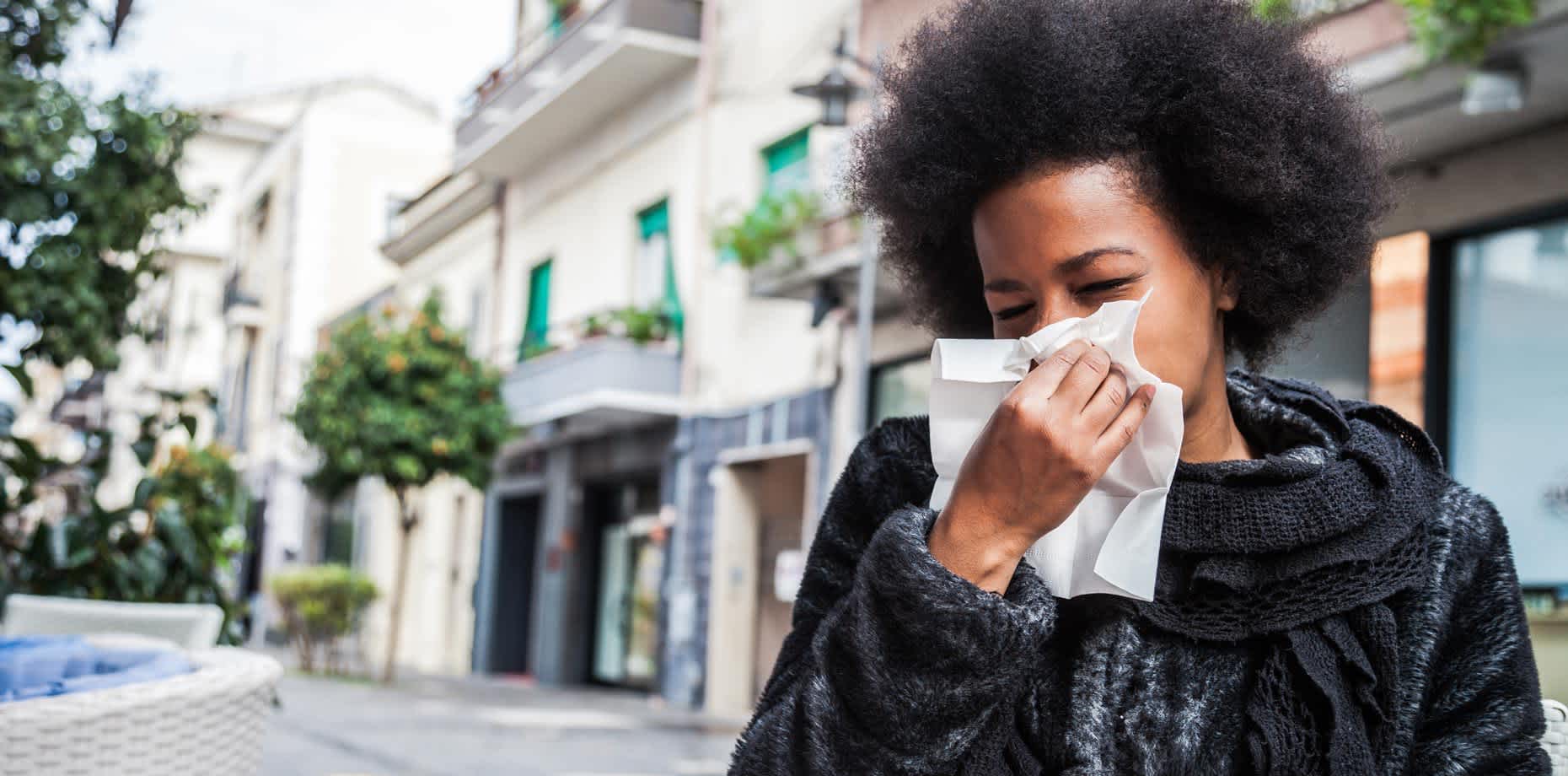
2021 Guide to the Worst Cities for People with Allergies
If you’re one of the 60 million people in the United States that experience allergies, you may dread seasonal shifts when your allergy symptoms begin to take over. You may also have noticed your symptoms lasting longer into the year or even getting worse. If so, you’re not alone. In fact, a 2012 study by the American College of Allergy, Asthma, and Immunology (ACAAI) reported that pollen counts are expected to more than double by 2040.
Why? Climate change due to global warming has a direct impact on allergies and other respiratory symptoms. Warmer climates result in longer growing seasons, which in turn produce more allergens like grass and pollen throughout the year. Poor air quality and increased CO2 levels can also increase the growth and production of certain allergens.
You may be wondering where to go if you suffer from allergy symptoms. The good news is that some places may be better than others, when it comes to relief from allergies. We collected data on climate, air quality, the number of board-certified allergists nearby, and Indoor & Outdoor Allergy Tests sold to determine the worst cities for allergies in the U.S.
Read on or skip to our infographic as we unveil the top 10 most challenging cities for people with allergies.
Table of Contents:
- Environmental factors that can increase allergies
- Worst cities for allergies
- Cities that purchased highest numbers of Everlywell allergy tests
- Common indoor & outdoor allergies
- Tips for managing allergy symptoms
- Methodology
Why Are Some Cities Worse for Allergies Than Others?
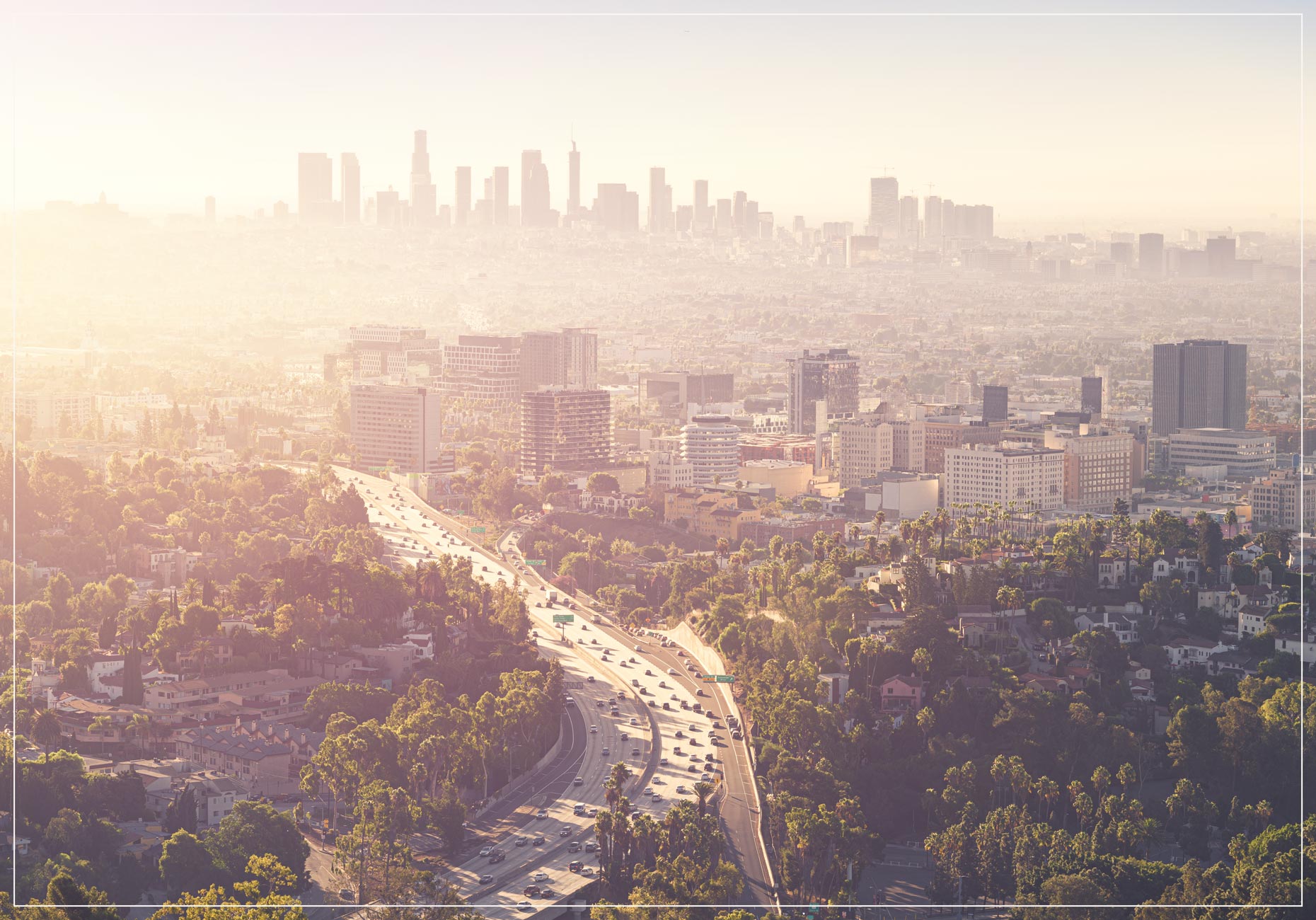
An area’s climate directly impacts the type and amount of existing allergens — this is why some cities may be worse for environmental allergies than others. Factors like temperature, air quality, and humidity can all affect the concentration of allergens in a region or city. What’s more, is that climate change will potentially lead to both higher allergen concentrations and longer growing seasons, causing more people to suffer from the health effects of pollen and other allergens.
To put it in layman's terms, warmer climates result in longer growing seasons, which in turn produce more allergens like grass and pollen throughout the year. Temperature increases could also cause a significant habitat expansion for tree species like oak and hickory trees, which are known to be common allergens.
Poor air quality and increased CO2 levels can also increase the growth and production of certain allergens. For instance, ragweed—a common allergen trigger of hay fever, which is a group of symptoms that affects the nose through either seasonal pollen allergies or perennial mold or dander allergies—grows faster and produces more pollen under increased carbon dioxide (CO2) levels. Air pollution and smog also cause higher levels of CO2, which in turn results in warmer temperatures, further continuing the cycle and contributing to the abundance of allergens.
Additionally, severe weather, with increased precipitation and extreme temperatures, can contribute to indoor air quality problems as well, and lead to increased humidity and mold growth.
What are the Most Challenging Cities for Allergies?
There are a number of cities to rethink planting your roots in if you suffer from allergy symptoms. These findings are pulled from the Asthma and Allergy Foundation of America 2020 Allergy Capitals report, which ranked cities based on allergen levels, including ragweed pollen counts, CO2 levels, growing season length, and the amount of over-the-counter medication sold in a calendar year.
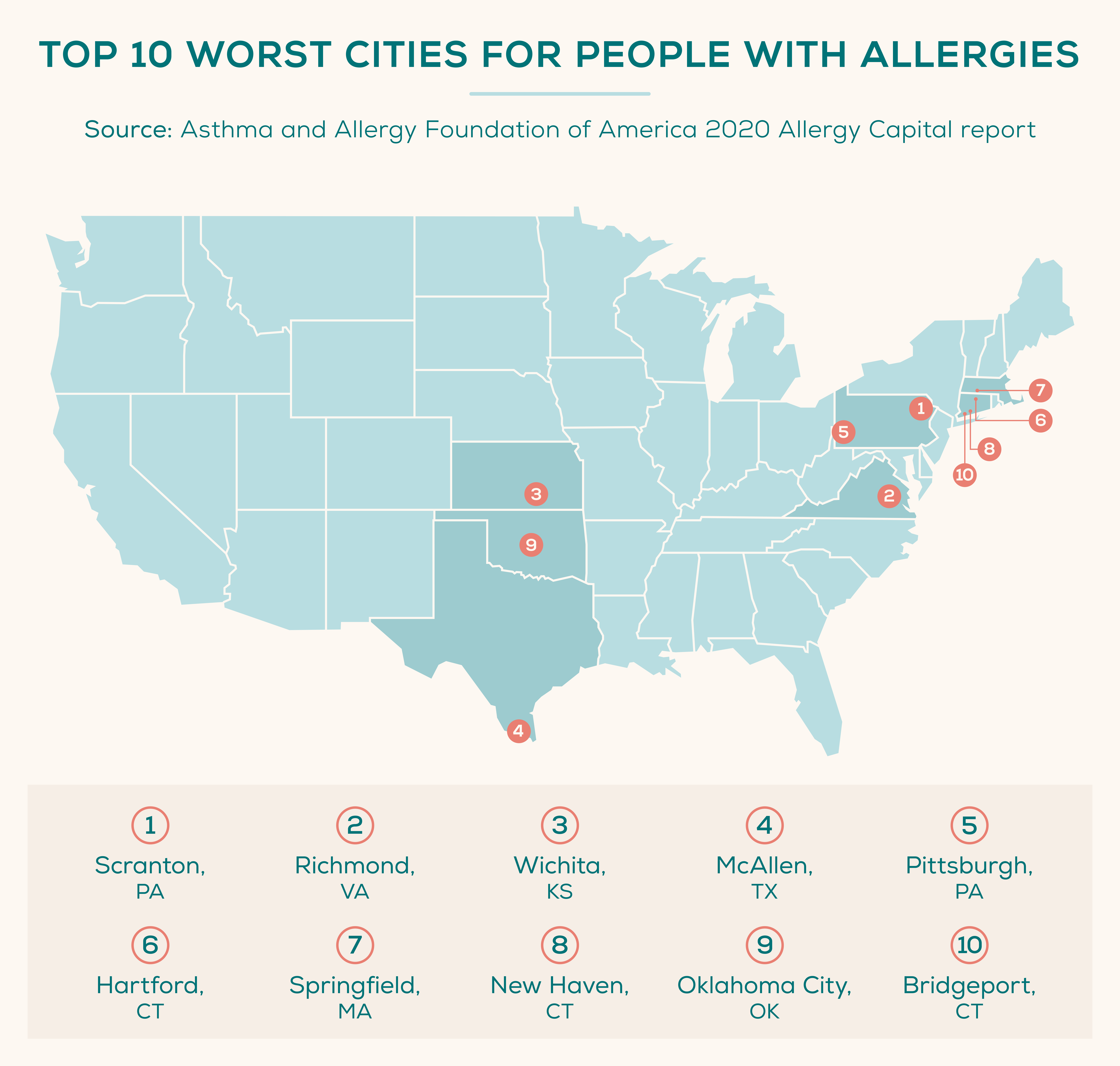
1. Scranton, PA
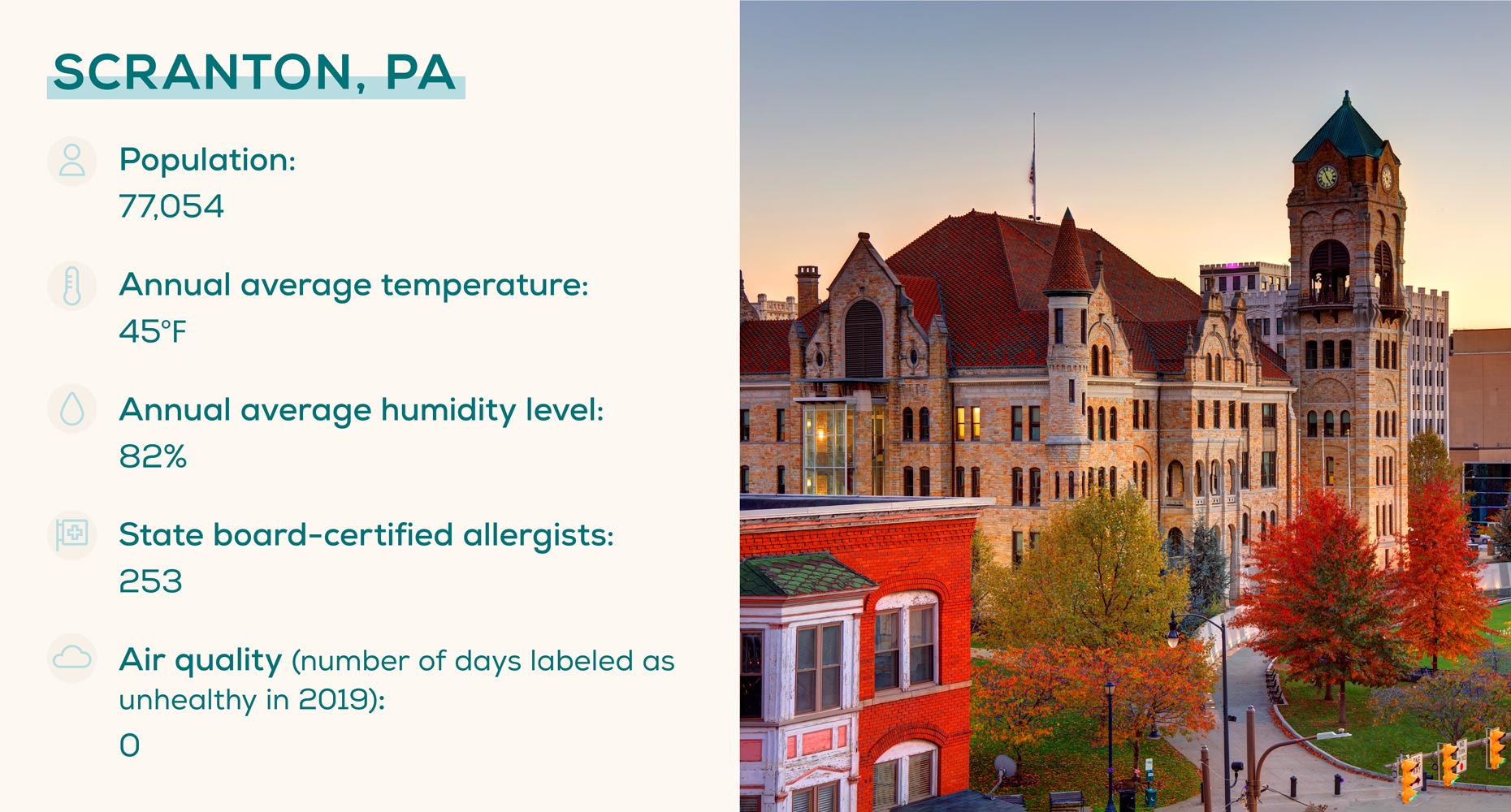
Coming in as the allergy capital of the United States, Scranton, Pennsylvania is the number one worst city for allergies.
Luckily, Scranton also has the highest rate of board certified allergists per 100,000 people—possibly due to the high demand of professionals needed in the area. So, allergy sufferers have several experts nearby who can offer relief or management recommendations.
2. Richmond, VA
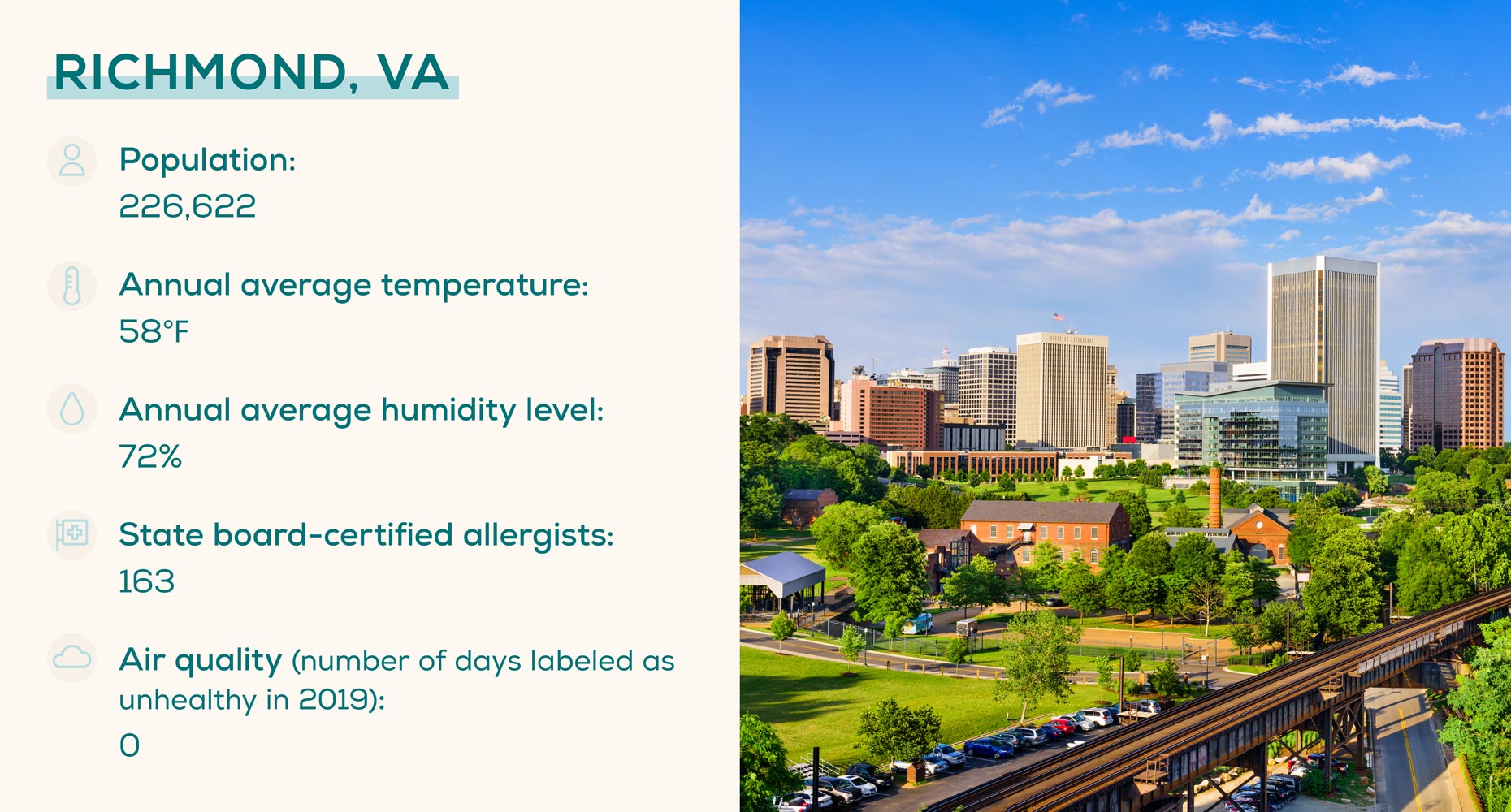
Virginia's capital city of Richmond, Virginia, comes in as the second-worst cities for allergy sufferers. Located on the James River, this city boasts water activities, parks, and historic landmarks that invite residents and tourists alike to spend time outdoors. That said, tree and grass pollen tend to be high during growing seasons, so be sure to check the pollen count before heading outside.
What’s more, Richmond's annual average humidity level is 72%, putting locals at a greater risk of indoor and outdoor exposure to mold spores compared to other states with a lower humidity level.
3. Wichita, KS
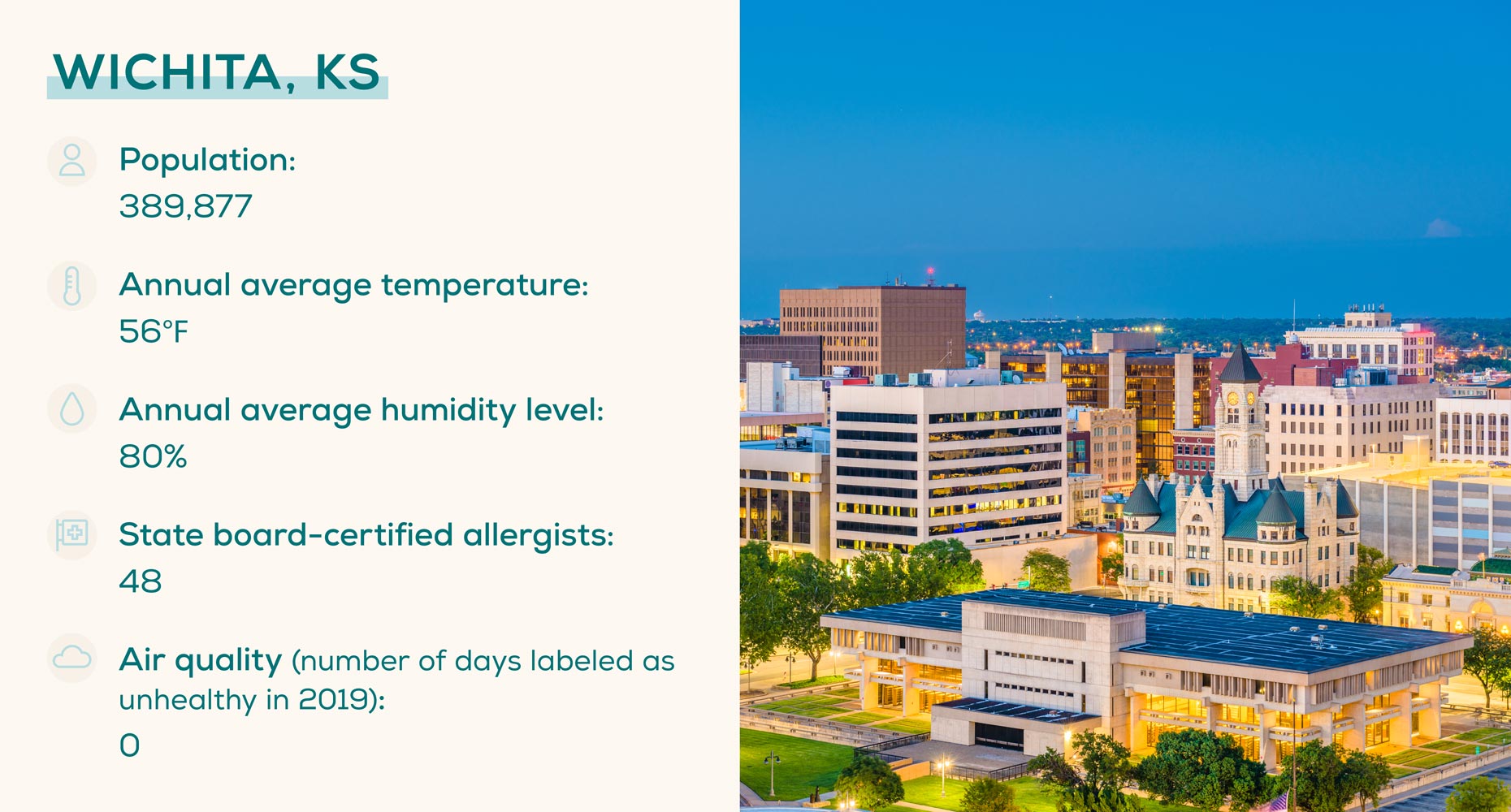
The largest city in Kansas, Wichita brings home the bronze as the third worst city for allergy sufferers in the country in both fall and spring. Wichita residents also experience a high level of humidity at 80% annually, which can exacerbate asthma and other allergies due to increased exposure to mold spores.
Tree pollen, grass pollen, and weed pollen all affect Wichita residents during their respective seasons.
4. McAllen, TX
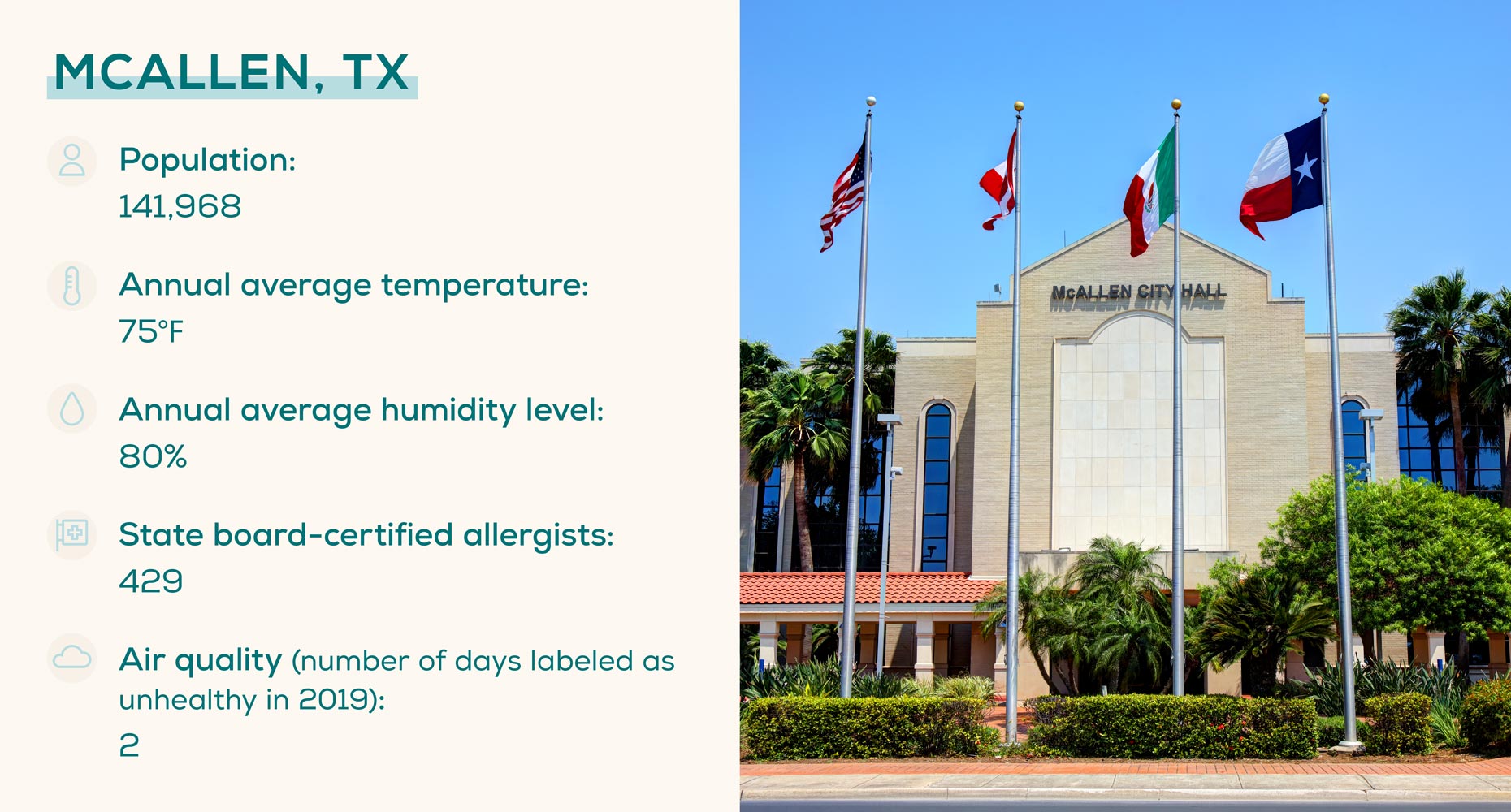
Located at the southern tip of the Lone Star State, McAllen is another city that challenges allergy sufferers. The high heat (average of 74.6 ℉ annually) and high humidity (80% annual average) pack a dual punch for those with allergies, creating an environment that allows allergens like mold and pollen to thrive.
5. Pittsburgh, PA
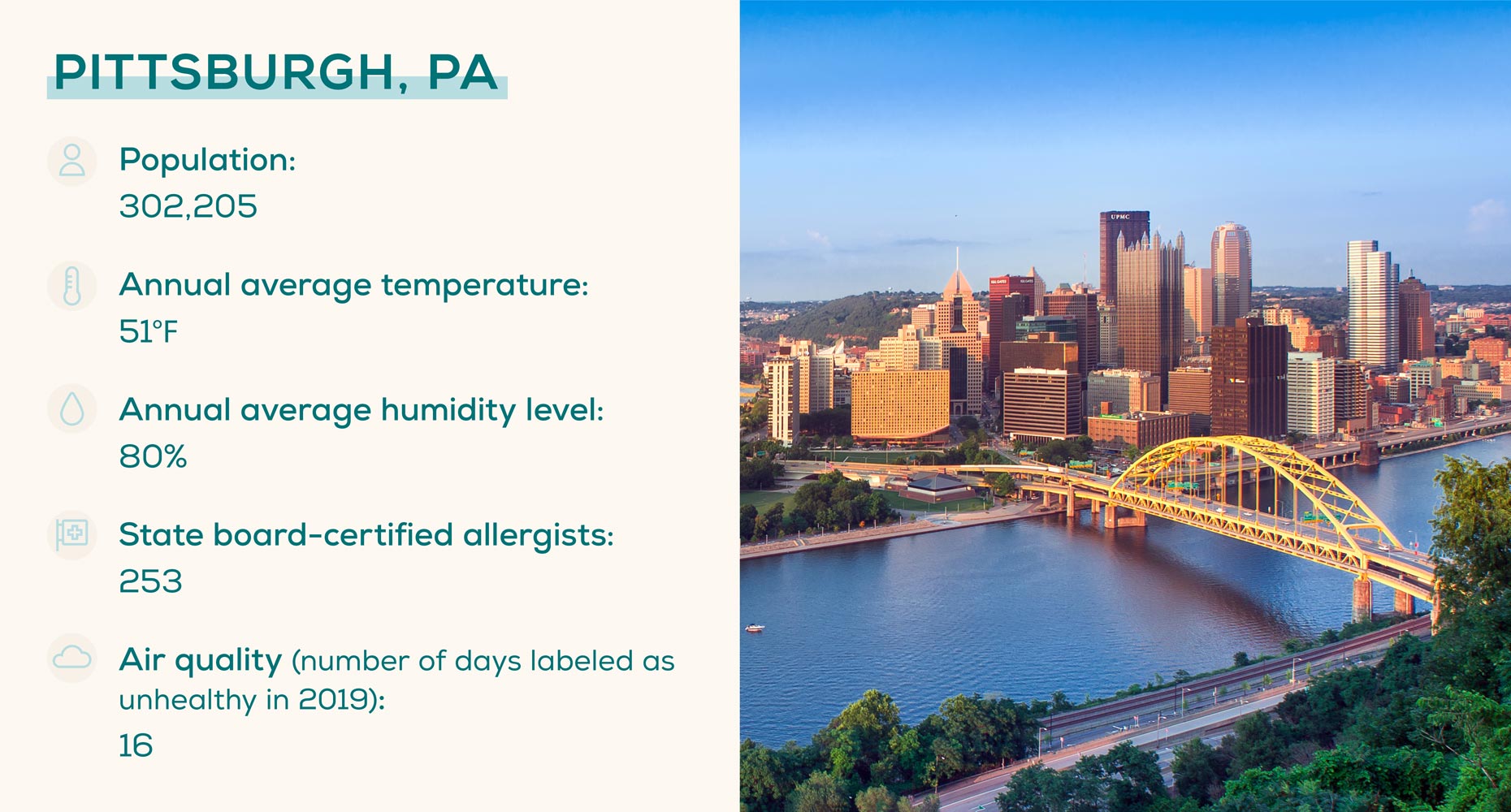
Pittsburgh experiences high humidity annually (80%) and poor air quality, making this city one allergy sufferers should think twice about visiting or living in.
With 16 days of air quality being counted as unhealthy in 2019, Pittsburgh is tied for the worst air quality on this list. To care for yourself in an area with poor air quality, it's recommended to check the air quality in your area to reduce or manage adverse reactions to airborne pollutants and allergens.
6. Hartford, CT
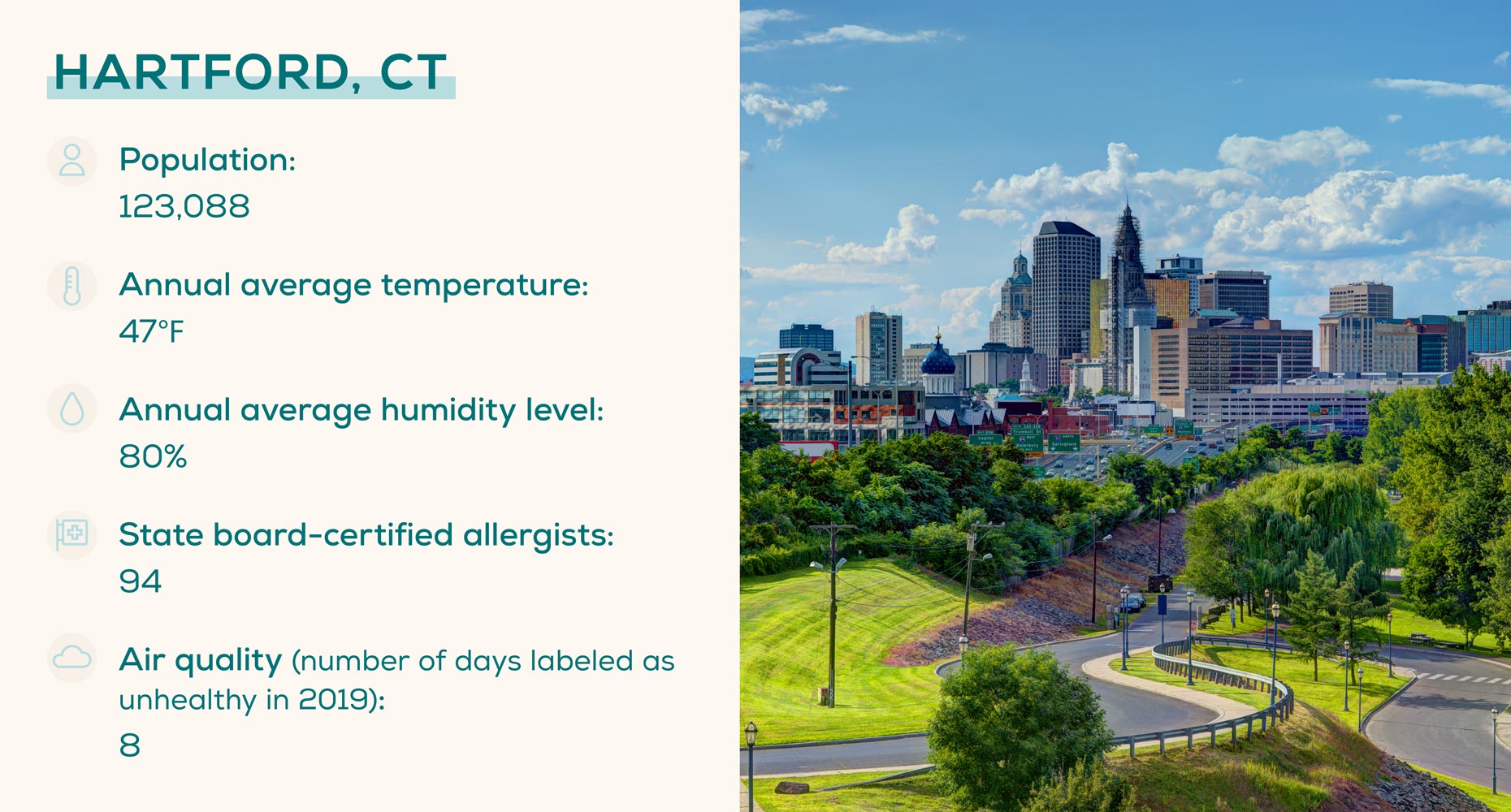
Hartford—Connecticut's capital, is rich with history and allergens. Common allergy-causing trees like oak, ash, birch, and maple grow in abundance there. What’s more, Harford ranked within the top 20 cities that purchased the Everlywell Indoor and Allergy Test in 2020.
Due to the lower annual average temperatures in Hartford, residents may spend more time indoors compared to other states on our lists. That said, it’s important to allergy-proof your home (such as removing mold, dust mites, and pet dander) if you or a family member are allergy-prone.
7. Springfield, MA
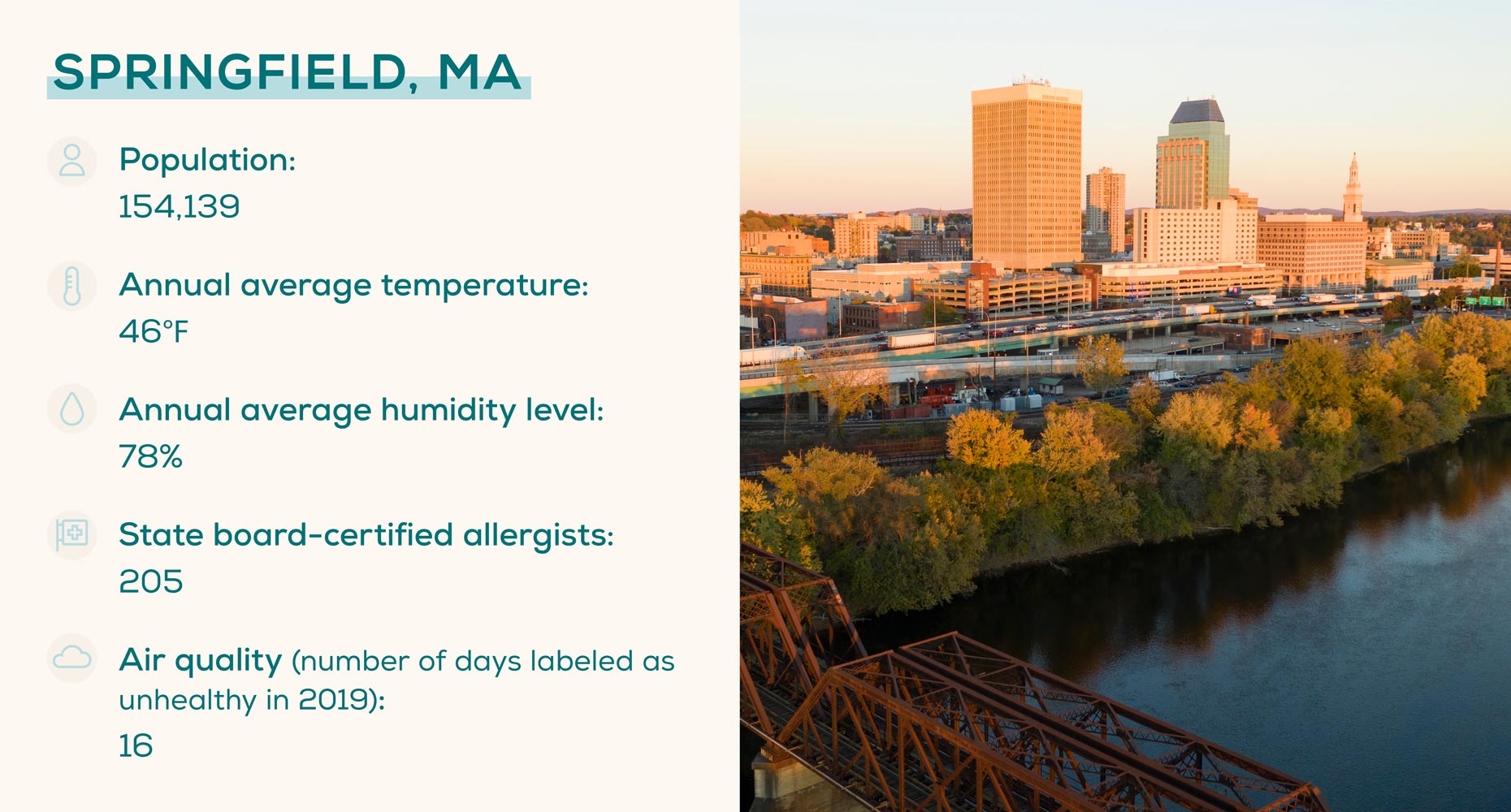
Among our list of challenge cities for allergy sufferers is Springfield, Massachusetts, which ranks 7th for the worst cities for allergies. The AAFA also ranks it as the worst city for those with asthma, so anyone visiting or living in Springfield with allergies or asthma should prepare accordingly.
Luckily, Springfield is also in second place for having the highest number of state-board certified allergists per patient prevalence, with 205. These professionals can help those suffering from allergies to find some relief.
8. New Haven, CT
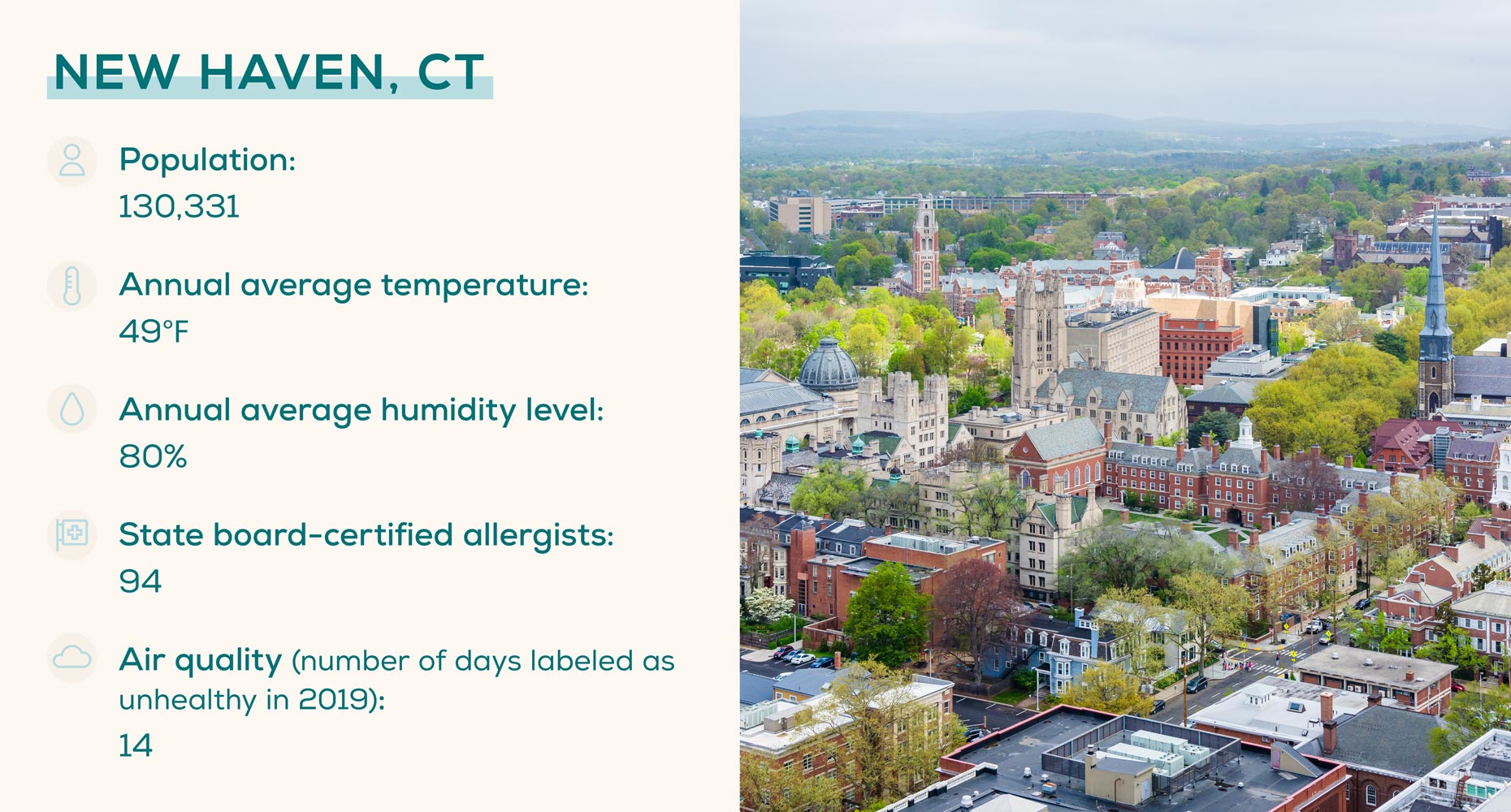
Home to the Ivy League campus of Yale University, New Haven is another city that proves challenging for those with allergies. Though New Haven does have a lower temperature than other cities (49℉), its high humidity (80%) and number of days labeled with unhealthy air quality (14) are factors that will exacerbate allergies, particularly mold allergies.
Some of the most significant allergens to blame in New Haven are ragweed pollen, bermudagrass, and bear oak.
9. Oklahoma City, OK
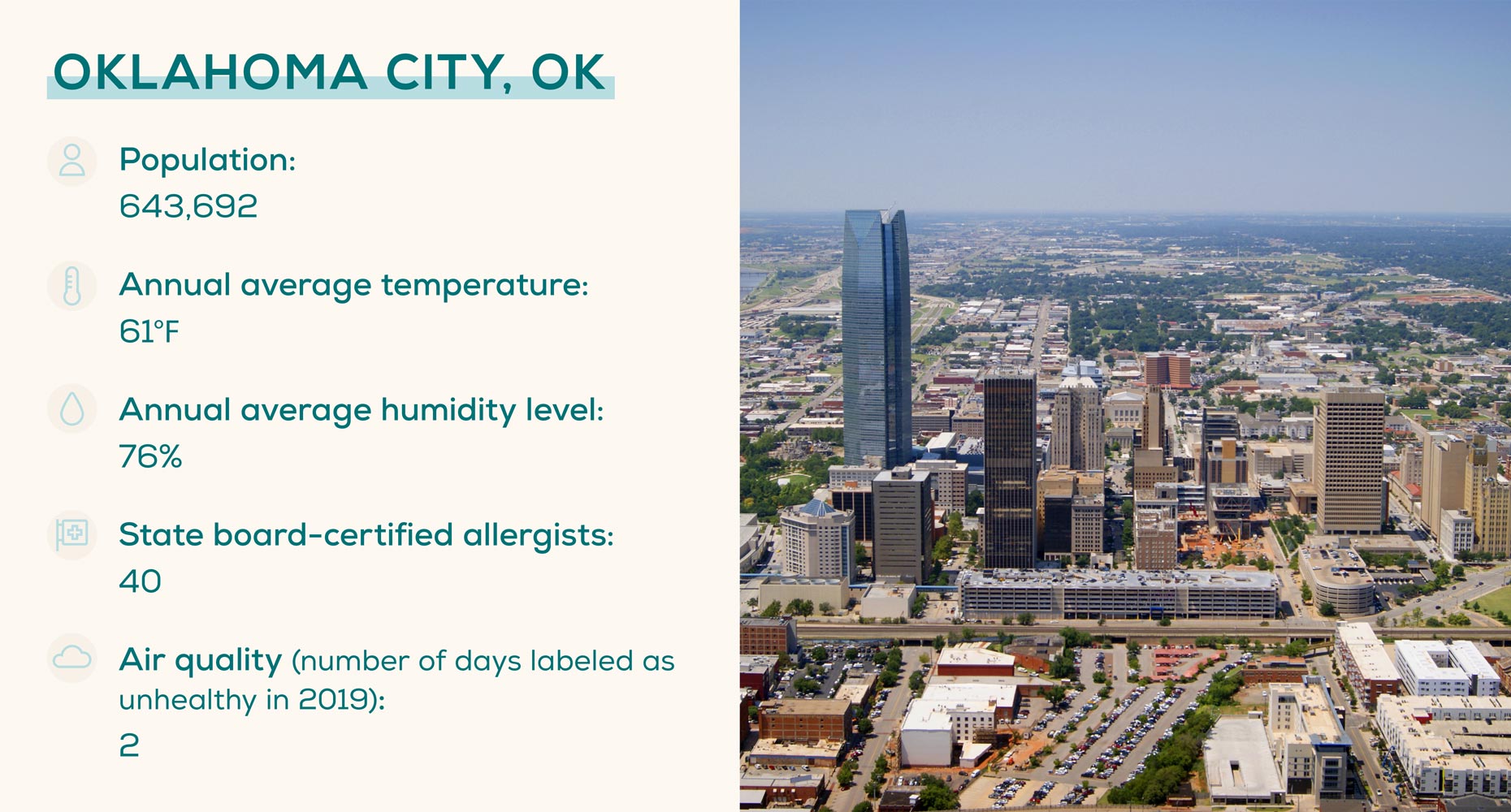
The capital city of Oklahoma has a high annual average temperature (61℉), and high annual average humidity level (76%), producing an environment that may not be ideal for allergy-prone people, but is perfect for allergens like mold and pollen.
Trees cause the majority of allergens in the city, with oak, hackberry, and mulberry trees being the most significant.
10. Bridgeport, CT
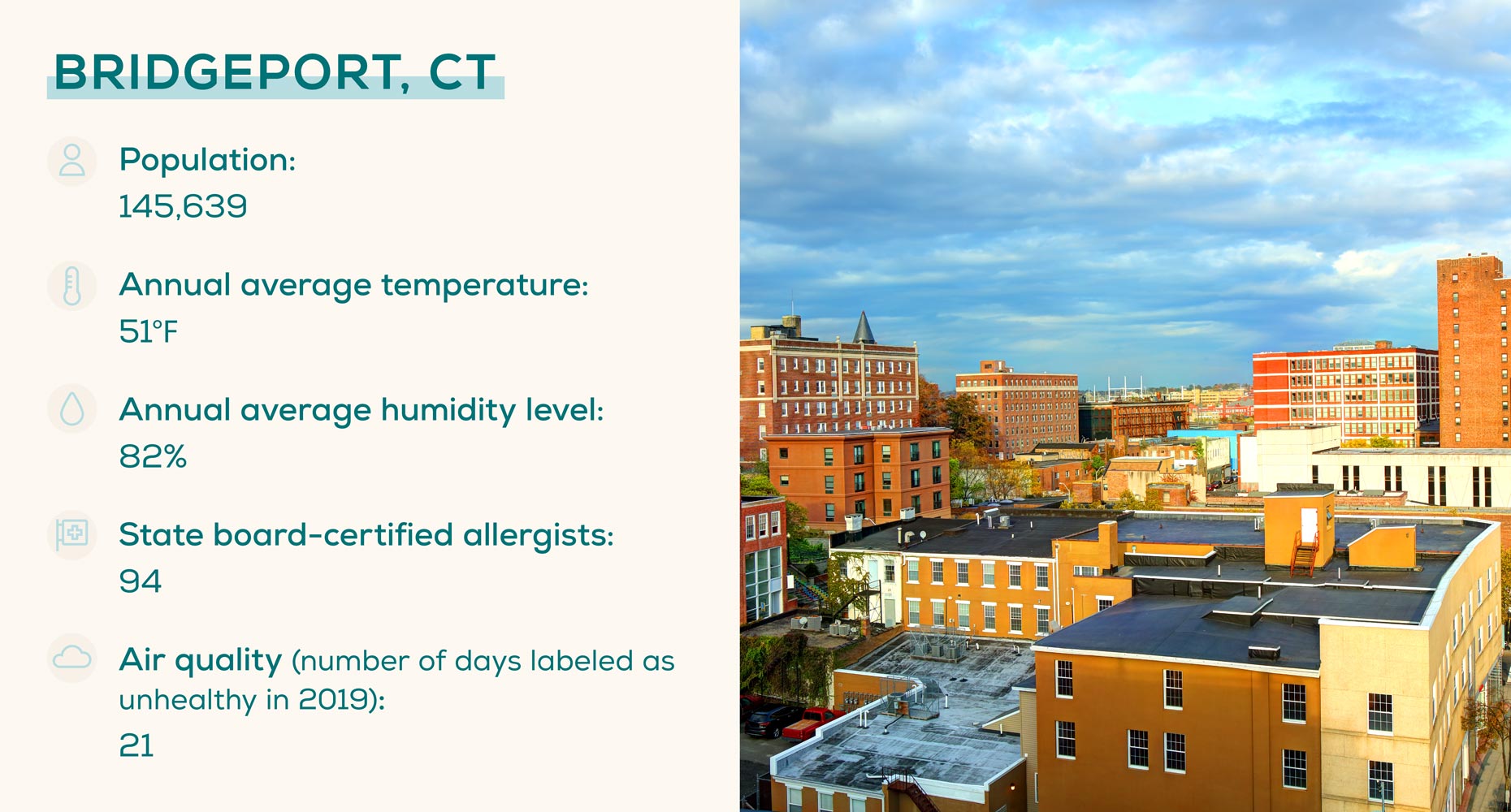
This historic seaport city boasts great seafood, idyllic New England views, and the highest number of days with unhealthy air quality in 2019 on this list (21). Those who are prone to allergies who live in the area or are visiting should follow simple management tips year-round like: track allergy counts and plan outdoor activities during certain times of the day.
With a high average humidity level of 82%, exposure to mold is more likely here than in other parts of the country since mold thrives in humid areas. If you live in Hartford or another part of the country with a higher humidity level, it’s important to regularly dust, sweep, and mop your home to reduce moisture buildup and mold spores from growing.
A simple way to keep your indoor air moisture-free is to invest in a dehumidifier. Dehumidifiers help remove water and humidity from the air and can reduce both mold, and dust mite build up.
Cities That Purchased The Most Everlywell Indoor & Outdoor Allergy Tests
Below, you'll find the top 10 cities that purchased Everlywell Indoor & Outdoor Allergy tests in 2020. Though the reasons for purchasing an indoor or outdoor allergy test will vary from person to person, the people of California really wanted to check their reactivities to common allergens — cities in the Golden State account for over half of the top 10 list this year.
- San Francisco, CA
- Dallas, TX
- Long Beach, CA
- Los Angeles, CA
- Newport Beach, CA
- Truckee, CA
- Denver, CO
- Hialeah, FL
- Tampa, FL
- Atlanta, GA
The Most Common Environmental Allergies Among Everlywell Test Takers
Based on testing results from the Everlywell Indoor & Outdoor Allergy test, which tests for IgE reactivity to 40 common allergens, we gathered the top 10 most common high-reactivity markers. See which indoor and outdoor allergens cause the most reactions across Everlywell test-takers in all areas of the U.S., and information about each type listed below.

Ryegrass: Ryegrass is a common grass allergy. This cool-season grass is widely used throughout the United States — most commonly used for fast germination and seedling growth. Although ryegrass is most naturally suited for more northern climates, southern lawn users use it as well.
Cat Dander: Cats produce multiple allergens (proteins that cause an allergy) that live on their fur, skin, and saliva. Homes with more than one cat may have more exposure to cat dander and may be more at risk of allergic reactions. If your cat spends time roaming outdoors, it may also bring allergens like dust and pollen into your home—and beware of "hypoallergenic cats," as studies have not supported the claim that cats can be hypoallergenic.
Timothy Grass: Timothy grass is common among temperate climates and prefers meadows, pastures, parkland, and roadsides. Timothy grass releases pollen from spring to fall, making it among the worst grass subspecies for hay fever.
Dog Dander: Similar to cats, dog’s also produce proteins found on their skin and fur that can cause allergens. Dog allergen levels increase if the dog lives indoors and are higher in the rooms where a dog is allowed. Studies have not found a breed of dog that is 100% hypoallergenic; however, there are breeds that are less likely to stimulate allergies in people. All dogs have saliva and dander, but some breeds produce less dander and saliva than others.
Dust Mites: Dermatophagoides farinae and Dermatophagoides pteronyssinus, otherwise known as the dust mite, are tiny bugs that commonly live in house dust and can cause allergy symptoms. These symptoms are caused by proteins in the dust that contain the feces and decaying bodies of dust mites. Dust mites eat skin cells that are shed by people and thrive in warm, humid environments. In most homes, dust mites live in bedding, upholstered furniture, and carpet.
Kentucky Bluegrass: Contrary to its name, Kentucky Bluegrass is not native to the United States or Kentucky; however it’s been introduced to some parts of North America. It’s most commonly grown in cool, humid climates. Many individuals who experience allergy symptoms from exposure to Kentucky bluegrass can also experience symptoms when exposed to other allergens such as tree, weed, or grass pollens due to cross-reactivity.
Sweet Vernal Grass: Sweet vernal grass, also known as buffalo grass, holy grass, and vanilla grass, is common in numerous places where pastures, roadsides, and lawns are common.
Birch Tree: Birch trees are grown throughout the cool regions of the Northern Hemisphere, and are known to trigger a condition known as Pollen Food Allergy Syndrome. This condition occurs in older teens and adults who experience an itchy mouth after eating raw fruits or vegetables, which can carry birch tree allergens.
Nettle: Nettle, is a well-known medicinal plant that has long been used in complementary and alternative medicine. However, nettle can also cause allergic rhinitis, which occurs when the immune system overreacts to something in the environment that doesn't affect others in the same way, including pollen, pet dander, mold, or dust mites. Nettle can be found in wet, nutrient-rich soil, lighted places, and hot and mild climates.
Johnson Grass: Individuals who have high reactivity to Johnson Grass may experience symptoms of hay fever, which affects the nose, eyes, and throat. Johnson Grass can be naturally found in warm, humid, and tropical climates.
Ways to Nip Allergies in the Bud
You don’t have to move to find relief. No matter where you live, there are simple methods to reduce your allergy symptoms.
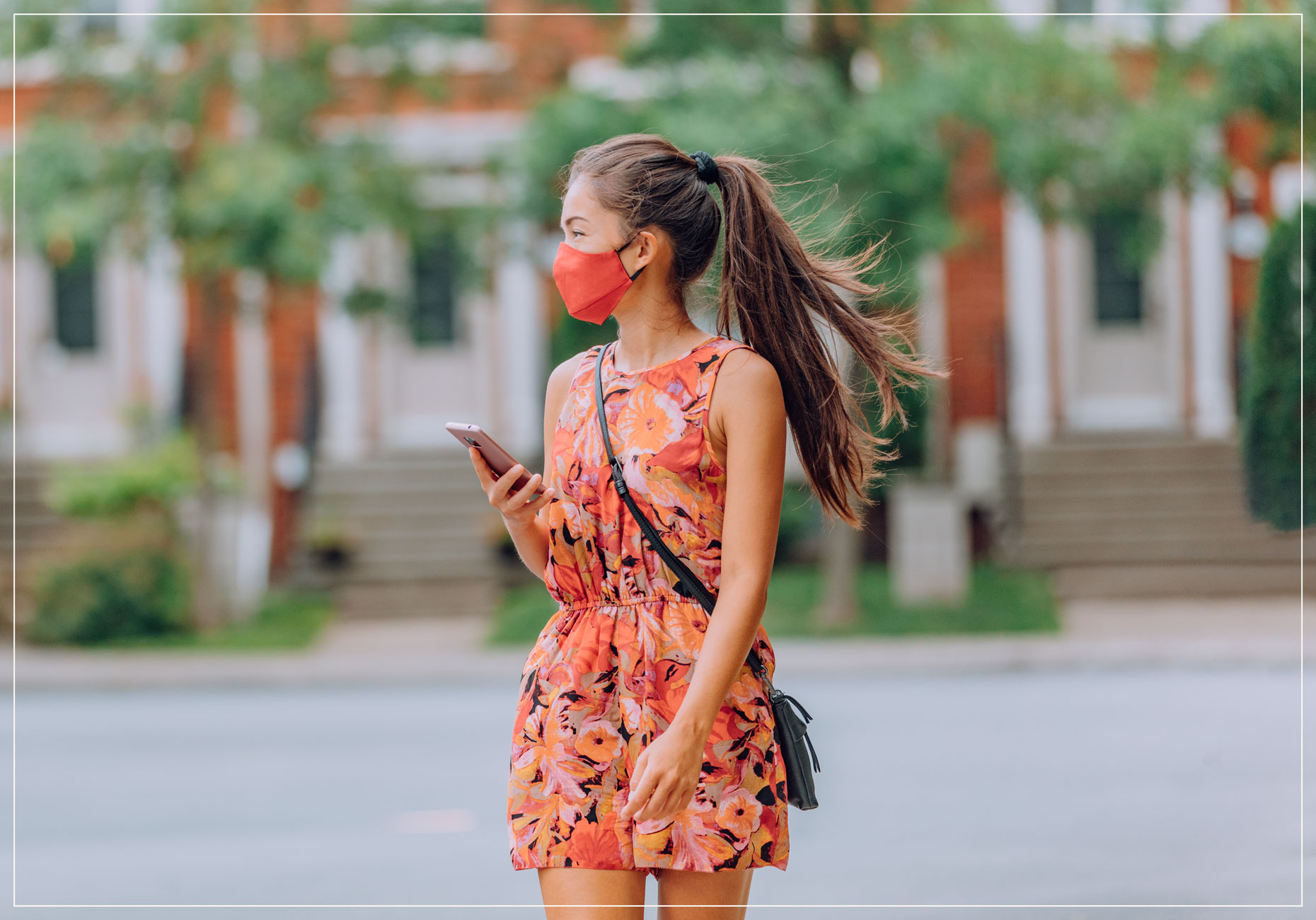
Reduce Exposure
After identifying your IgE reactivities to common allergens, you can take steps to reduce your exposure to your high reactivities which may be worsening your allergy symptoms. This could mean staying indoors on days where the mold or pollen counts are high, wearing a mask when doing outdoor chores, or delegating outdoor tasks that could promote symptom flare-ups.
Keep Indoor Air Clean
Allergens aren’t just outside; they exist inside too. Doing what you can to keep your indoor air clean could do wonders for your allergy symptoms, especially if allergens like dust, mold, or dander worsen your allergy symptoms. To reduce allergens and other airborne particles, make sure you are using high-efficiency particulate air (HEPA) filters and changing them routinely. Using an air purifier can also help keep indoor air clean.
Take a Shower After Being Outside
Allergens like pollen can cling to hair, skin, and clothing. After you’ve been outdoors, take a shower to wash off any allergy-causing particles. It’s a good idea to leave your shoes at the door as well, as shoes can bring the outside world in.
Visit a Specialist
If measures to reduce allergen exposure aren’t doing the trick, consider visiting an allergist or immunologist. These are doctors with at least two additional years of specialized training in the diagnosis and treatment of allergies, asthma, immune deficiencies, and other immunologic diseases. They may recommend allergy management or relief options like immunotherapy.
Methodology:
To determine the worst cities for allergies, we used the ranked cities inAsthma and Allergy Foundation of America's 2020 Allergy Capitals report. The AAFA ranks cities based on allergen levels, including ragweed pollen counts, CO2 levels, growing season length, and the amount of over-the-counter medication sold in a calendar year.
Average Temperature: Hotter average temperatures result in longer growing seasons, and more pollen. Average temperatures pulled from Climate Data.
Air Quality Index: Poor air quality contributes to CO2 levels, which in turn produces hotter climates and increased pollen production. The EPA establishes an AQI for five major air pollutants regulated by the Clean Air Act, which include: ground-level ozone, particle pollution, carbon monoxide, sulfur dioxide, and nitrogen dioxide. A good to moderate AQI ranges from 0-100. We evaluated the number of days each city had an AQI of 100 or greater. Data pulled from the Bureau of Transportation Statistics National Transportation Statistics report.
Humidity Levels: Mold spores spread in high humidity areas, both indoors and outside—which can contribute to allergic reactions year-round. The greater the humidity level, the higher your risk of fungal allergy exposure like mold and mildew. Humidity levels pulled from USA.com.
Board-Certified Allergists Per Area: Using the Board-Certified Allergists report listed per state then solved per 100k people.
